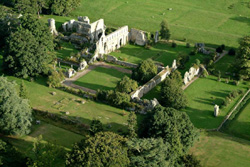 |
 |
 |
 |
 |
 |
 |
|
Fountains Abbey: History
Fountains Abbey: Buildings
|
What became of William Thirsk? (3/6) William met a rather unfortunate end. Following
his resignation from Fountains he retired to Jervaulx Abbey,
where his friend, Adam Sedbar, presided over the community. Jervaulx,
and indeed William Thirsk, became deeply embroiled in the uprising
against the government, known as the Pilgrimage
of Grace, and suffered
the consequences. In 1537 Thirsk was charged with treason and hanged,
drawn and quartered at Tyburn.(128) Marmaduke
Bradley kept himself and his community well away from trouble and
even reported one
of his
monks, a Robert Moreby, of speaking treasonous words when dining
at his table with Sir William Mallory in the spring of 1538.(129) |
